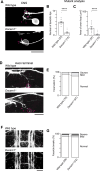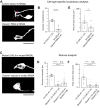Adjacent Neuronal Fascicle Guides Motoneuron 24 Dendritic Branching and Axonal Routing Decisions through Dscam1 Signaling
- PMID: 39349058
- PMCID: PMC11495862
- DOI: 10.1523/ENEURO.0130-24.2024
Adjacent Neuronal Fascicle Guides Motoneuron 24 Dendritic Branching and Axonal Routing Decisions through Dscam1 Signaling
Abstract
The formation and precise positioning of axons and dendrites are crucial for the development of neural circuits. Although juxtacrine signaling via cell-cell contact is known to influence these processes, the specific structures and mechanisms regulating neuronal process positioning within the central nervous system (CNS) remain to be fully identified. Our study investigates motoneuron 24 (MN24) in the Drosophila embryonic CNS, which is characterized by a complex yet stereotyped axon projection pattern, known as "axonal routing." In this motoneuron, the primary dendritic branches project laterally toward the midline, specifically emerging at the sites where axons turn. We observed that Scp2-positive neurons contribute to the lateral fascicle structure in the ventral nerve cord (VNC) near MN24 dendrites. Notably, the knockout of the Down syndrome cell adhesion molecule (Dscam1) results in the loss of dendrites and disruption of proper axonal routing in MN24, while not affecting the formation of the fascicle structure. Through cell-type specific knockdown and rescue experiments of Dscam1, we have determined that the interaction between MN24 and Scp2-positive fascicle, mediated by Dscam1, promotes the development of both dendrites and axonal routing. Our findings demonstrate that the holistic configuration of neuronal structures, such as axons and dendrites, within single motoneurons can be governed by local contact with the adjacent neuron fascicle, a novel reference structure for neural circuitry wiring.
Keywords: Axon; CNS; Drosophila; Dscam; dendrite; motoneuorn.
Copyright © 2024 Bui and Kamiyama.
Conflict of interest statement
The authors declare no competing financial interests.
Figures








Update of
-
Adjacent Neuronal Fascicle Guides Motoneuron 24 Dendritic Branching and Axonal Routing Decisions through Dscam1 Signaling.bioRxiv [Preprint]. 2024 Apr 12:2024.04.08.588591. doi: 10.1101/2024.04.08.588591. bioRxiv. 2024. Update in: eNeuro. 2024 Oct 22;11(10):ENEURO.0130-24.2024. doi: 10.1523/ENEURO.0130-24.2024. PMID: 38645010 Free PMC article. Updated. Preprint.
Similar articles
-
Adjacent Neuronal Fascicle Guides Motoneuron 24 Dendritic Branching and Axonal Routing Decisions through Dscam1 Signaling.bioRxiv [Preprint]. 2024 Apr 12:2024.04.08.588591. doi: 10.1101/2024.04.08.588591. bioRxiv. 2024. Update in: eNeuro. 2024 Oct 22;11(10):ENEURO.0130-24.2024. doi: 10.1523/ENEURO.0130-24.2024. PMID: 38645010 Free PMC article. Updated. Preprint.
-
Dscam1 is required for normal dendrite growth and branching but not for dendritic spacing in Drosophila motoneurons.J Neurosci. 2014 Jan 29;34(5):1924-31. doi: 10.1523/JNEUROSCI.3448-13.2014. J Neurosci. 2014. PMID: 24478371 Free PMC article.
-
Specification of Dendritogenesis Site in Drosophila aCC Motoneuron by Membrane Enrichment of Pak1 through Dscam1.Dev Cell. 2015 Oct 12;35(1):93-106. doi: 10.1016/j.devcel.2015.09.007. Dev Cell. 2015. PMID: 26460947 Free PMC article.
-
Regulatory mechanisms underlying the differential growth of dendrites and axons.Neurosci Bull. 2014 Aug;30(4):557-68. doi: 10.1007/s12264-014-1447-3. Epub 2014 Jul 8. Neurosci Bull. 2014. PMID: 25001617 Free PMC article. Review.
-
Mechanisms for axon maintenance and plasticity in motoneurons: alterations in motoneuron disease.J Anat. 2014 Jan;224(1):3-14. doi: 10.1111/joa.12097. Epub 2013 Sep 6. J Anat. 2014. PMID: 24007389 Free PMC article. Review.
Cited by
-
The VAPB Axis Precisely Coordinates the Timing of Motoneuron Dendritogenesis in Neural Map Development.Res Sq [Preprint]. 2024 Dec 31:rs.3.rs-5684747. doi: 10.21203/rs.3.rs-5684747/v1. Res Sq. 2024. PMID: 39801516 Free PMC article. Preprint.
References
MeSH terms
Substances
Grants and funding
LinkOut - more resources
Full Text Sources
Molecular Biology Databases
